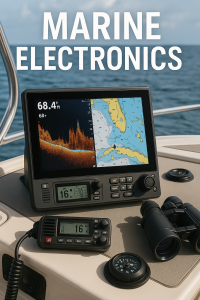Explore what marine electronics are, their types, applications, and trends. A complete guide for maritime students, cadets, ship officers, and marine professionals looking to master shipboard electronics and communication systems.
The Heartbeat of Smart Ships
Imagine navigating a mega vessel through rough seas without radar, GPS, or autopilot. Modern maritime operations would be nearly impossible without marine electronics—the vital systems that enable navigation, communication, safety, and control.
Whether you’re a maritime student, cadet, ship officer, or a shipping company executive, understanding marine electronics is essential in today’s digitally-driven industry. This comprehensive guide covers everything from the basics to the latest innovations.
What Are Marine Electronics?
Marine electronics refers to the range of electrical and digital systems used on ships and marine platforms for navigation, communication, automation, monitoring, and safety.
These systems are designed to:
-
Operate reliably in harsh marine environments
-
Interface with sensors, radars, and satellite systems
-
Improve operational safety, fuel efficiency, and compliance
🧭 Marine electronics are not optional anymore—they are mandatory for commercial vessels under SOLAS and other IMO conventions.
Core Types of Marine Electronics
🧭 1. Navigation Systems
-
GPS and GNSS Receivers: Provide position, speed, and course
-
Radar Systems: Detect surrounding vessels and obstacles
-
Electronic Chart Display and Information System (ECDIS): Digital navigation charts and route planning
-
Gyrocompass and Autopilot: Directional stability and automated steering
📡 2. Communication Systems
-
VHF/UHF Radio: Line-of-sight ship-to-ship or ship-to-shore communication
-
Satellite Communication (SATCOM): Global voice and data coverage
-
GMDSS (Global Maritime Distress and Safety System): Mandatory safety communication system for SOLAS ships
-
AIS (Automatic Identification System): Transmits vessel identity, course, and speed to others nearby
⚡ 3. Power and Control Systems
-
Engine Monitoring Systems
-
Integrated Bridge Systems (IBS)
-
Ballast Water Management Control
-
Emergency Shutdown and Fire Detection Systems
🎯 4. Fishing and Survey Electronics
-
Fish Finders and Echo Sounders
-
Sonar and Subsea Imaging Equipment
-
Multibeam and Side-scan Sonars for seabed mapping
Why Marine Electronics Are Essential
🌊 Enhancing Navigation Safety
-
Real-time awareness through radar and ECDIS
-
Minimizing human error with autopilot and decision-support tools
📈 Improving Operational Efficiency
-
Route optimization via GPS and weather overlays
-
Integrated systems help reduce fuel consumption and maintenance
⚓ Enforcing Regulatory Compliance
-
GMDSS and AIS mandated under SOLAS
-
Data logging for inspections and audits
📡 Supporting Remote Monitoring
-
Remote diagnostics and predictive maintenance
-
Fleet-wide updates and data analytics
Real-World Applications and Case Studies
🛳️ Case Study: Autonomous Shipping Trials
A Norwegian ferry equipped with integrated marine electronics and LiDAR sensors successfully completed remote and autonomous voyages in 2023, marking a major leap in maritime automation.
🚢 Oil Tanker Fleet Monitoring
A major oil shipping company implemented real-time engine performance dashboards across its fleet, saving 12% in annual fuel consumption and improving maintenance scheduling.
Educational Applications: What Students and Cadets Should Know
👨🎓 Topics to Study
-
Principles of marine radar and navigation
-
Electrical circuits and marine power systems
-
IMO requirements for GMDSS
-
Software integration and maritime cybersecurity
🎓 Certifications & Courses
-
STCW-compliant GMDSS training
-
Marine Electronics Technician (MET) certification
-
ECDIS Type-Specific Training
Future Trends in Marine Electronics
🌐 1. Integrated Maritime IoT Platforms
-
Real-time condition monitoring
-
Predictive analytics using AI and machine learning
🚀 2. Smart Navigation & Autonomous Ships
-
Collision avoidance through AI-assisted decision making
-
Autonomous route planning and vessel docking
🛰️ 3. Satellite Innovation
-
LEO (Low Earth Orbit) satellite networks for high-speed maritime internet
-
Enhanced global coverage for remote vessels
🔐 4. Cybersecurity Focus
-
IMO’s 2021 cybersecurity mandate has led to increased investment in firewalls, encryption, and secure communications
FAQs: People Also Ask
What are marine electronics used for?
Marine electronics are used for navigation, communication, vessel monitoring, engine control, safety systems, and environmental compliance.
What is the difference between marine electronics and general electronics?
Marine electronics are specially designed to function in harsh, corrosive, and moisture-rich marine environments. They are more rugged, waterproof, and compliant with maritime regulations.
How do you become a marine electronics technician?
You can pursue a diploma or degree in marine electrical/electronic engineering, followed by certification programs like GMDSS, ECDIS, and radar maintenance courses.
Are marine electronics required by law?
Yes. Commercial vessels must comply with IMO requirements, including systems like AIS, GMDSS, and ECDIS under SOLAS regulations.
Conclusion: Marine Electronics – The Backbone of Modern Seafaring
In a maritime world where safety, efficiency, and sustainability are paramount, marine electronics serve as the digital backbone of modern ships. For students entering the field and professionals advancing in it, mastering these systems is key to a successful maritime career.
⚓ Next Steps
-
Download Free GMDSS Compliance Checklist
-
Learn How to Become a Certified Marine Electronics Technician


